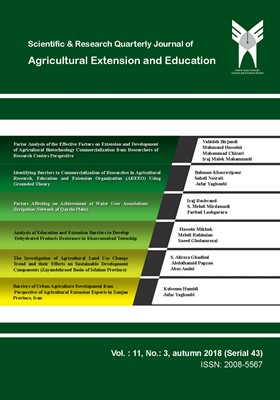-
-
List of Articles
-
Open Access Article
1 - Factor Analysis of the Effective Factors on Extension and Development of Agricultural Biotechnology Commercialization from Researchers of Research Centers Perspective
Vahideh Birjandi S. mahmoud Hosseini Mohammad Chizari Iraj Malek Mohammadi -
Open Access Article
2 - Identifying Barriers to Commercialization of Researches in Agricultural Research, Education and Extension Organization (AREEO) Using Grounded Theory
Bahman Khosravipour Soheil Nosrati Jafar Yaghoubi -
Open Access Article
3 - Factors Affecting on Achievement of Water User Associations (Irrigation Network of Qazvin Plain)
Iraj Rashvand mehdi Mirdamadi Farhad Lashgarara -
Open Access Article
4 - Analysis of Education and Extension Barriers to Develop Dehydrated Products Resistance in Khorramabad Township
Hossein Mikhak Mehdi Rahimian Saeed Gholamrezai -
Open Access Article
5 - The Investigation of Agricultural Land Use Change Trend and their Effects on Sustainable Development Components (Zayandehrood Basin of Isfahan Province)
sayed alireza ghadimi Abdolhamid Papzan Abas Amini -
Open Access Article
6 - Barriers of Urban Agriculture Development from Perspective of Agricultural Extension Experts in Zanjan Province, Iran
Kolsoum Hamidi Jafar Yaghoubi
-
The rights to this website are owned by the Raimag Press Management System.
Copyright © 2021-2025







